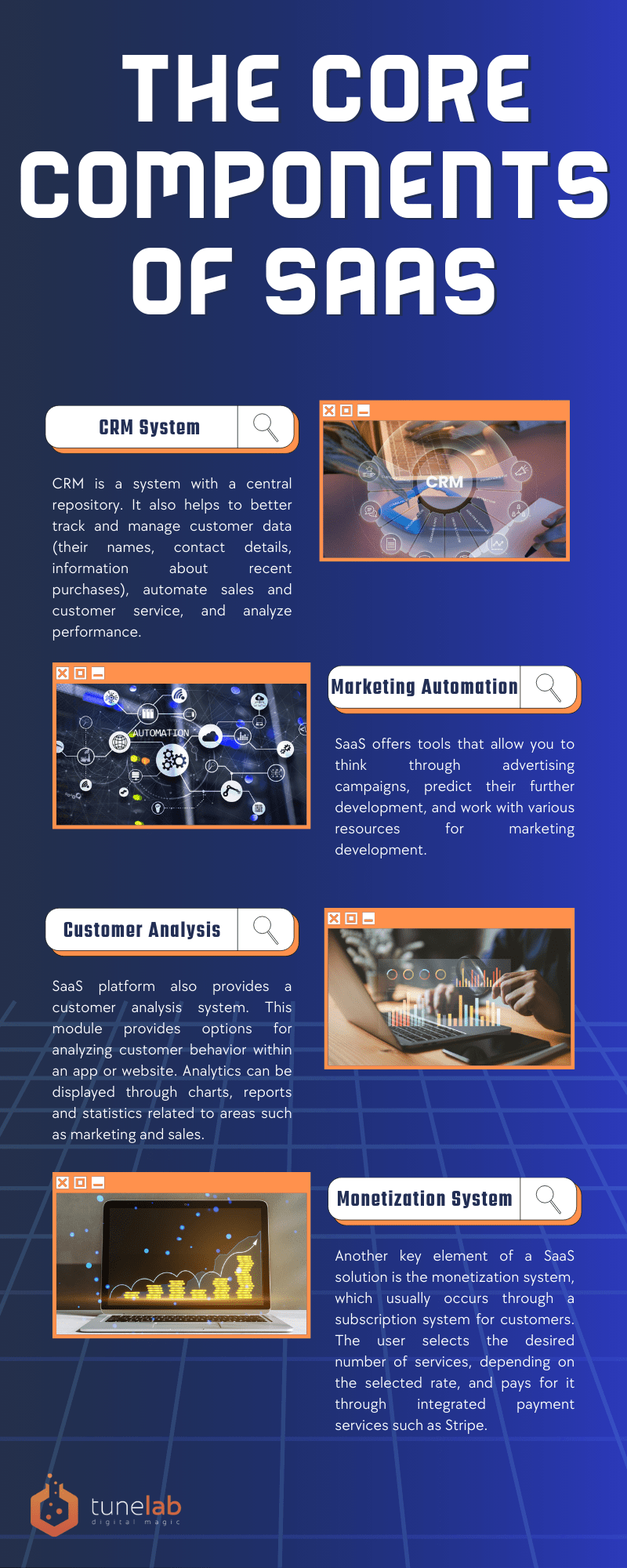World-famous companies such as Netflix, Amazon and eBay have long been actively using SaaS to provide their services. Because SaaS platforms allow companies to use programs over the Internet, without the need for installation on the device and further technical support. Also, companies are able to save money on a team of developers who would create software exclusively for the company itself.
Using SaaS platforms by companies significantly simplifies the management of business processes and reduces IT infrastructure costs, as well as provides enterprises with competitive advantages in the market. How exactly SaaS affects the development of companies – read more in our blog post.
SaaS Platforms: What They Are and How They Power Cloud Computing
SaaS (Software as a Service) is a type of software that runs on the provider’s server, and the user has access to the services for a separate payment or for free. This solution is convenient for companies, because they do not need to order and create a new separate web solution for their site, but can use a ready-made solution offered by other providers.
Under this service delivery model, the software is stored in cloud storage. The software vendor may enter into an agreement with the cloud technology provider, or the technology provider may own the cloud if it is a large corporation.
The Core Components of SaaS

First of all, a good SaaS platform includes a CRM system with a central repository. It also helps to better track and manage customer data (their names, contact details, information about recent purchases), automate sales and customer service, and analyze performance. In addition, CRM includes options for managing deals, automating marketing campaigns and much more.
CRM systems allow companies to better understand the needs of their customers, personalize offers and respond to requests faster, which has a positive effect on business development and increasing customer loyalty.
As for marketing automation, SaaS offers a set of tools that allow you to think through advertising campaigns, predict their further development, and work with various resources for marketing development. For example, automation of posting in social networks, tracking and analysis of the number of reactions from users, etc.
To improve customer service, the SaaS platform also provides a customer analysis system. This module provides options for analyzing customer behavior within an app or website. Analytics can be displayed through charts, reports and statistics related to areas such as marketing and sales.
Another key element of a SaaS solution is the monetization system, which usually occurs through a subscription system for customers. The user selects the desired number of services, depending on the selected rate, and pays for it through integrated payment services such as Stripe.
Exploring the Key Benefits of Cloud-Based Software
In particular, SaaS offers the following benefits to businesses and users:
- Intuitive and user-friendly interface. SaaS platforms are usually easy to use thanks to a clear and intuitive interface. This advantage will allow employees to quickly master the tool and start working on it quickly.
- The project scalability and flexibility. SaaS is a universal tool that can be adapted to the requirements and desires of both a small company and a larger enterprise.
- High level of security. Well-designed and high-quality SaaS solutions think through additional data security mechanisms, because a user enters data directly related to the company’s or customers’ activities to a third-party resource. These measures include multi-factor authentication, encryption and periodic audits.
- Saving money. Companies can save money because employees have one access to the software online instead of having to download a custom-made application to each server. In addition, companies save on the developers themselves, who create classic software for download to a computer.
- Updates and support. SaaS platforms are constantly updated and supported by the provider itself. A company does not need to spend additional time and money to update its software to the latest version – it is enough to press a button.
Exploring the Challenges of Cloud-Based Software Solutions
As with any solution that offers significant benefits to users, SaaS platforms have certain limitations and challenges that need to be addressed, including:
- Internet dependency. A significant number of SaaS solutions operate online, and the services provided by this platform may be unavailable due to a poor or no internet connection. However, usually companies with a good reputation think through the system of virtual or physical servers in such a way that in case of outages they always have spare servers or additional generators (if we are talking about physical storage).
- Data control and security concerns. Although the owners of quality SaaS platforms take additional measures to protect data, the use of SaaS platforms involves certain risks due to the introduction of data on someone else’s platform, which may be sensitive and confidential.
- Dependence on the owner of the system. If you use a SaaS solution offered by another company, you have a wide range of services. But, on the other hand, a user always remains dependent on the actions of the provider, and the user himself cannot influence updates and the duration of the platform’s existence.
The Best SaaS Platform Examples in Cloud Computing Services
The areas where SaaS is actively and successfully used are, in fact, very extensive: from e-commerce and manufacturing to the entertainment industry due to its versatility, flexibility and scalability.
The first example of a well-known and successful SaaS platform is Shopify, which is used by a large number of e-commerce companies. In fact, Shopify is the base for building an online store, and it covers many aspects of the online shopping process, from listing products to providing secure payment for products. Shopify is a beginner-friendly platform and it allows you to quickly develop and promote the growth of your business.
Some of the most famous examples of brands using Shopify as their platform include Kylie Cosmetics, Red Bull, Houseplant, Bombas, and more.
Another popular SaaS platform for managing internal business processes is Slack. Basically, Slack is a corporate messenger in which colleagues can communicate with each other and track their work progress. This platform can be used both online and downloaded to your device. Through Slack, you can create communication channels and private groups in which users receive messages in real time. Also, Slack can be connected to many other services, such as GitHub, Google Docs, Trello, Jira, etc. Some of the most prominent clients that actively use Slack include BuzzFeed, eBay, Wall Street Journal, PayPal, and more.
And when it comes to graphic design, businesses and individuals can use Canva graphic editor. It is a SaaS platform that offers ready-made templates for infographic designs, website images, web page designs, and more. The user of this platform has a large number of tools for modifying these templates using a set of graphic elements such as images, geometric shapes, text inserts, etc. And to make your custom design more unique, a Canva user has the option to upload your own images from your device or from social networks like Facebook, Instagram, and file hosting like Dropbox and Google Drive.
The last example we will mention in this article is the streaming service Netflix. Basically, it’s an online cinema where users register their accounts, pay for the services according to the monthly rate, and then choose the video content to watch according to their preferences. Video content produced or delivered by Netflix is available for viewing on any gadget – from a small smartphone screen to a large TV with a smart set-top box.
In conclusion, we can say that SaaS platforms are an integral part of modern business, because they provide companies with the opportunity to optimize work processes and reduce costs without significant capital investments. SaaS is popular due to its flexibility, scalability and ease of use, making these web solutions universal for both large corporations and small businesses.
Companies looking to stay competitive should seriously consider implementing SaaS into their business models. Inspired by the examples of eBay, Netflix and PayPal, companies will be able to focus on the development of core business lines, shifting responsibility for technical support and software updates to platform providers. These web solutions increase efficiency and provide access to the most advanced technologies, which are critical to success in the ever-changing business world.


